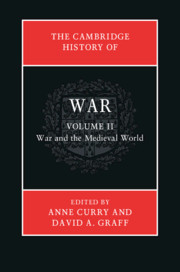Book contents
- The Cambridge History of War
- The Cambridge History of War
- Copyright page
- Contents
- Illustrations
- Maps
- Notes on contributors
- Introduction to volume II
- Part I Foundations, c.600–1000 ce
- Part II Interactions, c.1000–1300 ce
- Part III Nations and Formations, c.1300–1500 ce
- 13 Western Europe, 1300–1500
- 14 Warfare and Italian states, 1300–1500
- 15 The reconquest and the Spanish monarchies
- 16 The Byzantine empire and the Balkans, 1204–1453
- 17 Ottoman expansion and military power, 1300–1453
- 18 India, c.1200–c.1500
- 19 Southeast Asia, 1300–1540
- 20 Japan, 1200–1550
- 21 The Americas
- Part IV Comparisons: Cross-Cultural Analysis
- Select bibliography
- Index
20 - Japan, 1200–1550
from Part III - Nations and Formations, c.1300–1500 ce
Published online by Cambridge University Press: 25 September 2020
- The Cambridge History of War
- The Cambridge History of War
- Copyright page
- Contents
- Illustrations
- Maps
- Notes on contributors
- Introduction to volume II
- Part I Foundations, c.600–1000 ce
- Part II Interactions, c.1000–1300 ce
- Part III Nations and Formations, c.1300–1500 ce
- 13 Western Europe, 1300–1500
- 14 Warfare and Italian states, 1300–1500
- 15 The reconquest and the Spanish monarchies
- 16 The Byzantine empire and the Balkans, 1204–1453
- 17 Ottoman expansion and military power, 1300–1453
- 18 India, c.1200–c.1500
- 19 Southeast Asia, 1300–1540
- 20 Japan, 1200–1550
- 21 The Americas
- Part IV Comparisons: Cross-Cultural Analysis
- Select bibliography
- Index
Summary
Over a span of three and a half centuries (1200–1550) Japan experienced profound transformations in the institutions, ideals, and methods of war. Originally a limited, clearly defined and extraordinary event, warfare became an endemic and encompassing element of life in the mid sixteenth century. Earlier, small bands of mounted warriors, skilled in archery, arrived in camp and departed as they saw fit, for no institutional mechanisms existed for them to supply themselves or their followers with food and materials of war. By the sixteenth century, however, powerful magnates (daimyō) were capable of supplying and maintaining large armies, numbering in the thousands, largely composed of pike-wielding foot soldiers.
- Type
- Chapter
- Information
- The Cambridge History of War , pp. 523 - 553Publisher: Cambridge University PressPrint publication year: 2020
- 2
- Cited by

